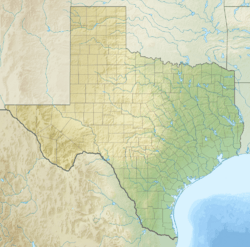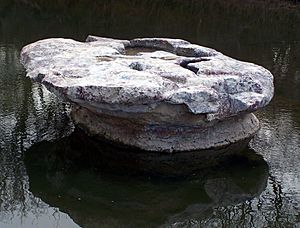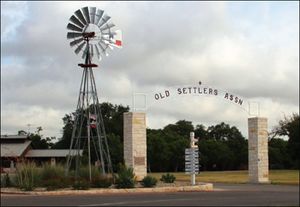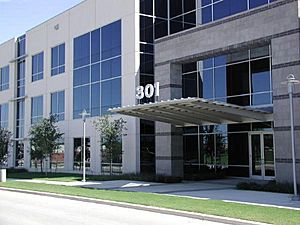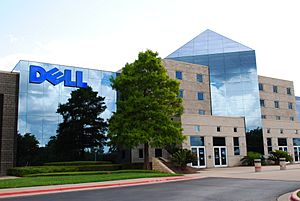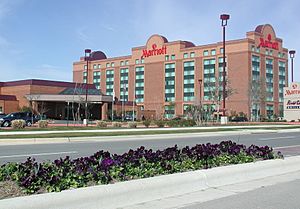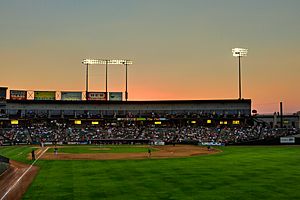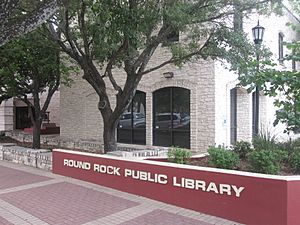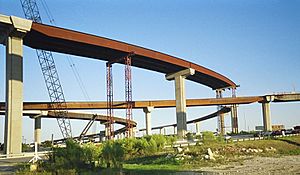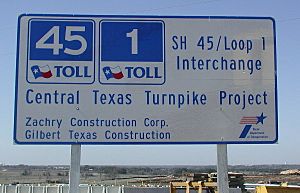Round Rock, Texas facts for kids
Quick facts for kids
Round Rock, Texas
|
|
|---|---|
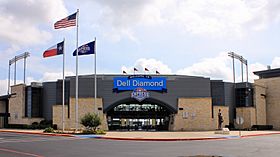
Dell Diamond baseball stadium in Round Rock
|
|
| Motto(s):
"Sports Capital of Texas"
|
|
| Country | |
| State | |
| Counties | Williamson, Travis |
| Incorporated | 1913 |
| Government | |
| • Type | Council-Manager |
| Area | |
| • Total | 38.00 sq mi (98.41 km2) |
| • Land | 37.64 sq mi (97.48 km2) |
| • Water | 0.36 sq mi (0.93 km2) |
| Elevation | 735 ft (224 m) |
| Population
(2020)
|
|
| • Total | 119,468 |
| • Estimate
(2021)
|
123,876 |
| • Rank | US: 221st TX: 28th |
| • Density | 3,174/sq mi (1,225.6/km2) |
| Demonym(s) | Round Rocker |
| Time zone | UTC−6 (Central (CST)) |
| • Summer (DST) | UTC−5 (CDT) |
| ZIP Codes |
78664, 78665, 78680–78683
|
| Area code(s) | 512 & 737 |
| FIPS code | 48-63500 |
| GNIS feature ID | 2411005 |
Round Rock is a city in the U.S. state of Texas, in Williamson County (with a small part in Travis County), which is a part of the Greater Austin metropolitan area. Its population is 119,468 according to the 2020 census.
The city straddles the Balcones Escarpment, a fault line in which the areas roughly east of Interstate 35 are flat and characterized by having black, fertile soils of the Blackland Prairie, and the west side of the Escarpment, which consists mostly of hilly, karst-like terrain with little topsoil and higher elevations and which is part of the Texas Hill Country. Located about 20 miles (32 km) north of downtown Austin, Round Rock shares a common border with Austin near Texas State Highway 45.
In August 2008, Money named Round Rock as the seventh-best American small city in which to live. Round Rock was the only Texas city to make the Top 10. In a CNN article dated July 1, 2009, Round Rock was listed as the second-fastest-growing city in the country, with a population growth of 8.2% in the preceding year.
According to the 2008 ratings from the Texas Education Agency, the Round Rock Independent School District ranks among the best in the state. Of 42 schools within it, 12 were rated exemplary and 11 were recognized.
Round Rock is perhaps best known as the international headquarters of Dell, which employs about 16,000 people at its Round Rock facilities. The presence of Dell along with other major employers, an economic development program, major retailers such as IKEA, a Premium Outlet Mall, and the mixed-use La Frontera center, have changed Round Rock from a sleepy bedroom community into its own self-contained "super suburb".
Contents
History
Prehistoric Round Rock
Round Rock and Williamson County have been the site of human habitation since at least 9,200 BC. The earliest known inhabitants of the area lived during the late Pleistocene (Ice Age), and are linked to the Clovis culture around 9,200 BC (11,200 years old) based on evidence found at the much-studied "Gault Site," midway between Georgetown and Fort Hood. One of the most important discoveries in recent times is that of the ancient skeletal remains dubbed "The Leanderthal Lady" because of its age and proximity to Leander, Texas. The site is 4 miles (6 km) west of Round Rock and was discovered by accident by Texas Department of Transportation workers while drilling core samples for a new highway. The site has been extensively studied for many years and samples carbon date to this particular Pleistocene period at approximately 10,500 years ago (8,500 BC). Prehistoric and Archaic Period "open occupation" campsites are also found throughout the county along streams and other water sources including Brushy Creek in Round Rock and the San Gabriel River in Georgetown, ten miles (16 km) north. These archeology dig sites show a much greater volume of evidence of Archaic Period inhabitants based on relics and flint tools recovered from burned rock middens. The earliest known "historical" Native American occupants, the Tonkawa, were a flint-working, hunting people who followed the buffalo on foot and periodically set fire to the prairie to aid them in their hunts. During the 18th century they made the transition to a horse culture and used firearms to a limited extent. There also appear to have been small numbers of Kiowa, Yojuane, Tawakoni, and Mayeye Native-Americans living in the county at the time of the earliest Anglo settlements. After they were crowded out by white settlement, the Comanches continued to raid settlements in the county until the 1860s. In the late 19th century, Native Americans were being pushed out of Central Texas.
As the area developed into a rural Anglo community, some of the modern paved roads actually followed the original Native-American pathways. One famous immigration route passed through Round Rock and is called the "Double File Trail" because the path was wide enough for two horsemen to ride side-by-side. It is part of a longer trail from north Texas that crossed the San Gabriel River in Georgetown, Brushy Creek in Round Rock, and the Colorado River in Austin. An elementary school in the Round Rock school district is named for the trail, Double File Trail Elementary School.
19th century history
In 1851, a small community was formed on the banks of Brushy Creek, near a large round and anvil-shaped rock located in the middle of the creek. This round rock marked a convenient low-water crossing for wagons, horses, and cattle. The first postmaster called the community "Brushy," and the creek was called "Brushy Creek". But in 1854, at the suggestion of the postmaster, the small settlement was renamed Round Rock in honor of this now famous rock. After the Civil War, Jesse Chisholm began moving cattle from South Texas through Round Rock on the way to Abilene, Kansas. The route he established, which crossed Brushy Creek at the round rock, became known as the Chisholm Trail. Most of the old buildings, including the old Saint Charles Hotel, have been preserved. This historic area is now called "Old Town."
The Sam Bass era of the 1870s
Downtown Round Rock was the site of an historic gunfight and subsequent capture (and death) of the 19th-century American train robber Sam Bass, by the Texas Ranger Division on July 19, 1878. The Rangers followed Bass and his gang after they robbed the Fort Worth-to-Cleburne train. Bass was tracked to Round Rock and as he attempted to flee, Bass was shot and killed in a gun battle by Ranger George Herold and Ranger sergeant Richard Ware. Near Ware was Soapy Smith, a noted con man, and his cousin Edwin, who witnessed Ware's shot. Soapy exclaimed, "I think you got him." The event is known locally as the "Sam Bass Shootout." This shootout is re-created each year at the July 4 'Frontier Days' Celebration in Old Settlers Park. Bass is buried in Round Rock Cemetery, located northwest of "Old Town" on Sam Bass Road. His original headstone can be found on display at the Round Rock Public Library.
Cotton
In the first half of the 20th century the county's wealth came from the cotton fields. Cotton, row-crops, grapes, and truck farming were the predominant subsistence east of Interstate 35. West of the Balcones divide ranchers raised cattle, sheep and to a lesser extent goats. Due to Round Rock's favorable geographic location over the rich, fertile "blackland prairie" soils also known locally as the "black waxy" (due to the soil's high clay content), cotton was the largest economic driver at that time. Because of the soil and climate, this eco-region is ideally suited to crop agriculture. Nearby Taylor, Texas, east of Round Rock, was the primary cotton center where the crop was hauled for ginning (its seeds mechanically removed) at the cotton gin, compressed into bales, and shipped by train. Austin was also a cotton center for a time once the railroad arrived there in the 1870s. Cotton production and cattle raising, on a much smaller scale, continues today although primarily east of Round Rock.
Chisholm Trail Crossing Park
To preserve the heritage of the famous crossing, a Chisholm Trail Crossing Park was developed to provide visitors with a simulated scene of Round Rock's historical role in the Chisholm cattle drive. Commemorative plaques in the park tell of the history of Round Rock. The bronze sculptures of four steers and pioneer woman Hattie Cluck and her son, Emmitt, were commissioned by the city through donations from Round Rock residents. The sculptures depict Round Rock's history as a crossing location along the Chisholm Trail. The project plans include 18 to 20 additional bronze statues over time.
Old Settlers Association
Following the end of the American Civil War a group of Confederate veterans held a reunion in Georgetown on August 27, 1904, for the old settlers of Williamson County and their descendants. The invitation promised "good music, plenty to eat, and above all a warm welcome." The event was well-attended, and reunions — now called Old Settlers Association (OSA) reunions — have been held annually ever since. After the initial one, the event was moved to Round Rock and eventually a structure was built (along with three restored log cabins) in the Palm Valley area of Round Rock, in front of Old Settlers Park, just off Highway 79 in east Round Rock. All members of the organization are descendants of Williamson County residents prior to 1904. OSA has approximately 50 active members and 300 members total. The Old Settlers Association today is a social and educational group, with the purpose of facilitating social activities, as well as collecting and preserving important historical information and facts. The facilities are rented for meetings, arts and craft and collectable shows, events, parties, weddings and rehearsal dinners.
The economic impact of Interstate 35
In the 1950s, Taylor was the economic powerhouse in the county due to it being the center of cotton production and shipping and had a large population. So it was expected, then, that the proposed Interstate 35, part of the new Interstate Highway System would pass through Taylor on its way from Dallas to Austin. In fact, the original routing plans drawn by Highway Commissioner DeWitt Greer called for the "interregional" highway to go through Taylor. Some of the citizens and leadership of Taylor lobbied against the Taylor route citing multiple concerns ranging from the loss of farmland, to unwanted right of way (ROW) acquisition — it was proposed to be an astounding 300 feet (90 m) wide, unheard of before this time—the possibility of cutting farmers off from their fields or having their fields be located on opposite sides of the road, traffic noise, and loss of country life. No one even knew what an "Interregional Highway" would look like. Instead they wanted improvements to the farm-to-market roads and a straight route to Austin.
Meanwhile, Round Rock leaders wanted the highway to come their way as they were focused on the potential economic development opportunities it would bring. At that time no one had ever seen such a road as an "Interstate" (unless they had traveled to Germany to see the Autobahn or Connecticut), but then-Mayor Louis Henna lobbied hard at the Highway Commission for the Round Rock route. In June 1956, the fifteen-year debate over the form, funding and route of the Interstate was resolved. Due to the heavy lobbying effort, and not wanting to antagonize Taylor, the route was eventually changed and the highway was built along the edge of the Balcones Fault line running through Round Rock. The precise route was not without opposition, however, as the final route cut off "Old Town" to the west from what had become the more recent "downtown" area east of Interstate 35. The Interstate eventually made Round Rock into a viable and vibrant commercial center. Due to the Interstate and the reduction in the importance of cotton as a primary crop, Taylor is today a minor, modest town with a smaller population, while Round Rock has thrived and rapidly grown into the largest city in the county, attracting companies like Dell Computer and major retail centers. The transformation of Round Rock is detailed in a book by Linda Scarborough (publisher of the Williamson County Sun newspaper) titled Road, River and Ol' Boy Politics: A Texas County's Path from Farm to Supersuburb published by Texas State Historical Press.
Life as a bedroom community
By the 1990s, Round Rock was primarily a bedroom community with the majority of its employed residents working in Austin and then returning home after work to places like Round Rock and Georgetown where housing and land was less expensive. In the 1990s, Round Rock had few major employers and jobs other than local retail and other services, or ranching and farming. But in the late 1990s, that began to change as economic development became a major focus of the city and the Chamber of Commerce. Dell Corporation (later renamed Dell) moved its headquarters to Round Rock which has provided a significant number of jobs with 16,000 employees at its Round Rock headquarters .(See also the Business and economic development section in this article.)
Geography
Round Rock is located 17 miles (27 km) north of downtown Austin, and 10 miles (16 km) south of Georgetown. Its elevation is 709 ft (216 m).
According to the US Census Bureau, the city has a total area of 26.3 square miles (68.0 km2), of which 26.1 square miles (67.7 km2) are land and 0.1 square mile (0.3 km2) (0.50%) is water.
Prior to the 2010 census, the city annexed part of the Brushy Creek CDP, increasing its total area to 35.9 square miles (93 km2), of which, 35.6 square miles (92 km2) of it is land and 0.3 square miles (0.78 km2) is water.
Climate
The climate in this area is characterized by generally hot, humid summers and mild, cool winters. According to the Köppen Climate Classification system, Round Rock has a humid subtropical climate, abbreviated "Cfa" on climate maps.
Demographics
| Historical population | |||
|---|---|---|---|
| Census | Pop. | %± | |
| 1880 | 628 | — | |
| 1890 | 1,438 | 129.0% | |
| 1900 | 1,138 | −20.9% | |
| 1910 | 1,245 | 9.4% | |
| 1920 | 900 | −27.7% | |
| 1930 | 1,005 | 11.7% | |
| 1940 | 1,173 | 16.7% | |
| 1950 | 1,683 | 43.5% | |
| 1960 | 2,458 | 46.0% | |
| 1970 | 2,811 | 14.4% | |
| 1980 | 12,740 | 353.2% | |
| 1990 | 30,923 | 142.7% | |
| 2000 | 61,136 | 97.7% | |
| 2010 | 99,887 | 63.4% | |
| 2020 | 119,468 | 19.6% | |
| 2022 (est.) | 126,697 | 26.8% | |
2020 census
| Race / Ethnicity (NH = Non-Hispanic) | Pop 2000 | Pop 2010 | Pop 2020 | % 2000 | % 2010 | % 2020 |
|---|---|---|---|---|---|---|
| White alone (NH) | 40,113 | 53,924 | 56,027 | 65.61% | 53.99% | 46.90% |
| Black or African American alone (NH) | 4,560 | 9,254 | 11,552 | 7.46% | 9.26% | 9.67% |
| Native American or Alaska Native alone (NH) | 210 | 288 | 312 | 0.34% | 0.29% | 0.26% |
| Asian alone (NH) | 1,727 | 5,056 | 9,668 | 2.82% | 5.06% | 8.09% |
| Pacific Islander alone (NH) | 5 | 105 | 177 | 0.09% | 0.11% | 0.15% |
| Some Other Race alone (NH) | 69 | 167 | 714 | 0.11% | 0.17% | 0.60% |
| Mixed race or Multiracial (NH) | 891 | 2,135 | 5,274 | 1.46% | 2.14% | 4.41% |
| Hispanic or Latino (any race) | 13,511 | 28,958 | 35,744 | 22.10% | 28.99% | 29.92% |
| Total | 61,136 | 99,887 | 119,468 | 100.00% | 100.00% | 100.00% |
As of the 2020 United States census, there were 119,468 people, 41,896 households, and 29,962 families residing in the city. The 42,580 housing units had 32,338 owner-occupied homes with a median value of $172,500. Of the 41,896 households, 29.7% had children under the age of 18 living with them, 60.5% were married couples living together, 11.0% had a female householder with no husband present, and 24.4% were not families. About 18.1% of all households were made up of individuals, and 3.0% had someone living alone who was 65 years of age or older. The average household size was 2.87, and the average family size was 3.29.
In the city, the age distribution was 31.9% under 18, 8.5% from 18 to 24, 38.8% from 25 to 44, 16.3% from 45 to 64, and 4.5% who were 65 or older. The median age was 32 years. For every 100 females, there were 98.6 males.
The per capita income for the city was $30,605.
Round Rock, with a population of more than 130,000, is located 15 miles north of Austin in the Central Texas Hill Country. It is the 28th most populous city in Texas, according to Texas Demographic Center.
Economy
The City of Round Rock has maintained a high quality of life while becoming a major center for economic growth in Central Texas, with industry clusters in clean energy, advanced manufacturing, life sciences, and computer/software development.
Round Rock has more than 20 major employers including: Cerilliant Corporation, Cintas, Dell, Dresser, Emerson Process Management, Hospira, IKEA, KoMiCo Technology Inc., Round Rock Premium Outlets, Prudential Overall Supply, Sears Customer Care, Texas Guaranteed Student Loan Corp, Tekscend Photomask, and TECO-Westinghouse.
Dell corporate headquarters
Dell, a multinational computer and information technology corporation based in Round Rock, develops, sells and supports computers and related products and services. The company employs about 11,500 people in the Round Rock facilities, and as of 2017, about 138,000 people worldwide. Dell was originally based in Austin after its formation in 1984 as PC's Limited by UT college student Michael Dell. With the need for significant space as it expanded, the City of Round Rock in 1996 offered Dell a "Chapter 380" agreement by offering to split sales tax revenue from in-state sales 50/50 between Dell and the city. (A "Chapter 380" agreement is named for the chapter in Vernon's Statues that permits sales tax revenue sharing for economic development purposes.) It was the first time such an agreement had been used in Central Texas and among the first in the state. As of 1999, approximately half of the general fund of the City of Round Rock originates from sales taxes generated from the Dell headquarters. Today, the company is one of the largest technology companies in the world, listed as number 38 on the Fortune 500 (2010). Fortune also lists Dell as the #5 most admired company in its industry. As part of its clean energy program in 2008, Dell switched the power sources of the Round Rock headquarters to more environmentally friendly ones, with 60% of the power coming from TXU Energy wind farms and 40% coming from the Austin Community Landfill gas-to-energy plant operated by Waste Management, Inc.
Commercial and retail
Round Rock's largest commercial and office business center is La Frontera, at the intersection of Loop 1, SH 45, and IH-35. La Frontera combines multi-tenant offices, company headquarters facilities, 1,000,000 square feet (90,000 m2) of retail, and several apartment complexes and other smaller retail and housing centers. The project also includes Williamson County's largest hotel, the Austin North Marriott, which provides space for large conferences, meetings, and banquets — a first for the county and an important component of Round Rock's economic efforts. The center is also home to the Texas Guaranteed Student Loan Corporation, and Emerson Process Management. The retail portion is the second-largest outdoor commercial project in the Austin-Round Rock metro area. La Frontera was developed by Bill Smalling and Don Martin, with Fort Worth financier Ed Bass as financial partner.
In 2006, a retail-only hub opened in Round Rock at the corner of IH-35 and Highway 1431 (now renamed "University Boulevard"), across the street from IKEA. The major-retailer center includes the Simon Property Group's Premium Outlets Mall, as well as numerous other retail stores and restaurants. The project was developed by Simon Property Group, with other portions by Barshop and Oles of Austin.
Sports
Round Rock is home to the Round Rock Express, a Triple-A Minor League Baseball team of the Pacific Coast League, owned by RSR Sports (Nolan Ryan, Don Sanders, Reid Ryan) and was founded by Reid Ryan, son of Baseball Hall of Famer Nolan Ryan. As of August 2010, Nolan Ryan is also the new owner of the major league Texas Rangers ball club. Home games for the Express are played at the Dell Diamond, a facility that is owned by the City of Round Rock and leased long-term to RSR Sports, which runs and maintains the facility.
Round Rock opened a free public skate park in 2007 behind the Clay Madsen Recreation Center on Gattis School Road.
Round Rock is the self-proclaimed "Sports Capital of Texas". The city's Old Settlers Park offers a professionally designed disc golf course, cricket, cross country running, twenty-field baseball complex, five-field softball complex, and seven soccer facilities in addition to the Rockin' River Family Aquatic Center.
The 11th annual US Quidditch Cup championship quidditch tournament was hosted in Round Rock in April 2018.
Education
Public education
Round Rock Independent School District, a Texas Education Agency recognized school district, is in southern Williamson County and northwest Travis County, and includes all the City of Round Rock and portions of the cities of Austin and Cedar Park. The area covers 110 square miles (280 km2) encompassing high-tech manufacturing and urban retail centers, suburban neighborhoods, and farm and ranch land. Roughly 45,00 students attend the district's five high schools, ten middle schools, 32 elementary schools, and two alternative learning centers.
In August 2010, the district opened its fifth high school (Cedar Ridge High School), a ninth-grade center reverted to a middle school, and the district's 31st elementary school opened in the Stone Oak subdivision. "The average student-teacher ratio for the district is 16. The annual dropout rate for students in grades 7–12 is 1.1%, and more than 77% of the district's graduating seniors take the SAT and ACT college entrance exams, scoring well above state and national averages." The property tax rates are significantly higher than the national average, and the schools' performance reflects the tax dollars invested.
- Students: 44,781 (as of fall 2010)
- Languages spoken: 77
- Average SAT score: 1628 (the state average is 1462 and the national average is 1509)
- Average ACT score: 24.1 (the state average is 20.8 and the national average is 21.0)
In the annual report released July 30, 2010, the Round Rock Independent School District received the highest possible rating ("Exemplary") for 25 of its schools, the highest number so rated in any of the suburban districts in Central Texas. These schools are: Westwood High School. Canyon Vista, Walsh, and Cedar Valley middle schools. Spicewood, Forest North, Caraway, Brushy Creek, Laurel Mountain, Fern Bluff, Canyon Creek, Great Oaks, Teravista, Cactus Ranch, Sommer, Deep Wood, Robertson, Pond Springs, Live Oak, Old Town, Jollyville, Forest Creek, Blackland Prairie, Union Hill and Gattis elementary schools. In 2010, the school district as a whole was rated "academically recognized", a significant step above 2009 when the school district was rated "academically acceptable" by the Texas Education Agency.
Round Rock is partially served by Leander Independent School District & Pflugerville Independent School District
Higher education
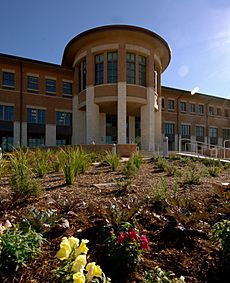
Round Rock also has a number of higher education opportunities. In 1990, the city, under the leadership of then-City Manager Bob Bennett, planning director Joe Vining, and local citizen Mike Swayze envisioned and oversaw creation of the Texas State University Round Rock Campus (or Round Rock Higher Education Center). The concept was envisioned as a way to lure colleges and universities to jointly provide education, training, and degree opportunities on part-time and full-time bases. The center used various empty facilities around town, and many of the initial training programs were targeted to help educate students for work at local companies, such as Dell, which had specialized needs. In 2008, an educational campus and the first RRC building—the Avery Building—was opened through the combined efforts of Texas State University, Austin Community College, and Temple College in order to provide a broader range of educational opportunities, specialized training, and varying degree programs including post graduate degrees. The campus is in the heart of the emerging Avery Center development which houses Seton Williamson, the A&M Health Science Center and other medical campuses. By the end of 2009 1,700 students were enrolled in the programs. Texas State University has taken on the lead role in this effort and 100 acres (40 ha) of land for the facility and additional buildings were donated by the Avery family of Round Rock, whose family members were early settlers on the land surrounding the center. Construction on the second Texas State campus building is underway and construction is nearly complete on this additional classroom building. (See also Texas State University Round Rock Campus)
The city is also home to the Texas A&M Health Science Center Round Rock, which opened its doors in December 2010. The campus is designed to eventually accommodate as many as 17 additional buildings over time as money is appropriated each biennium by the Texas Legislature.
In August 2010, Austin Community College's largest campus to date opened adjacent to the Texas State University center. ACC is constructing five additional buildings with a total of 250,000 square feet (23,000 m2) to accommodate up to 5,000 students in its first phase. All three campuses are adjacent to each other within the burgeoning Avery Farms development.
The newest component of higher education is the School of Nursing at Texas State University, housed within the university's College of Health Professions. Other programs offered by the college are health information management, health services research, and physical therapy.
Infrastructure
Transportation
Major highways
 Interstate 35
Interstate 35 U.S. Highway 79 (the southern terminus is here)
U.S. Highway 79 (the southern terminus is here) State Highway 45
State Highway 45 State Highway 45 Toll Rd
State Highway 45 Toll Rd State Highway 130 Toll Rd
State Highway 130 Toll Rd
Toll roads
In November 2006, the Central Texas Regional Mobility Authority (CTRMA) opened the first segment of the region's first toll road system. Both State Highway 130 and State Highway 45 toll roads run through portions of Round Rock and provide greatly increased mobility to the city, albeit with strong regional opposition to the high-toll charges to motorists. State Highway 130 runs just south of Austin Bergstrom International Airport at US Highway 183 and connecting to Interstate 35 north of Georgetown, and passes through the easternmost portion of Round Rock. It provides Round Rock residents with quick access to the Austin airport for about $6 each way. The project, when completed, will end at Interstate 10 just east of Seguin, about 30 miles (50 km) east-northeast of San Antonio essentially creating a parallel roadway to Interstate 35.
State Highway 45 is part of an eventual loop that runs east from State Highway 183 in Cedar Park to 130 at Pflugerville (east of Round Rock) where it merges with the SH 130 toll road, and then intersects with the southern portion of SH 45 near Buda, south of Austin. SH 45 passes through the entire southern portion of Round Rock. Highway 45 provides much faster access between Round Rock and Austin, alleviating what was previously a major bottleneck at Interstate 35. The project includes a tolled extension to Loop 1 (also known locally as the "Mopac Expressway") and allows direct access from to I-35 to Loop 1 by use of flyover connections rather than ground level intersections. The toll roads also provide access to the Dell headquarters and its considerable number of employees. Together, both toll roads significantly improve mobility in Round Rock.
Notable people
- Barbette, female impersonator
- Juanita Craft, politician and civil rights activist
- Ryan Goins, professional baseball player
- Colleen LaRose, alleged terrorist
- Donnie Little, football player
- Soapy Smith, confidence man and gangster
- Billie Lee Turner, botanist
- Anike, formerly known as Wande, rapper and A&R administrator
- Jarrett Allen, professional basketball player
Filming locations
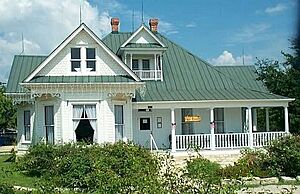
- The 1974 horror movie cult classic The Texas Chain Saw Massacre was filmed at various Central Texas locations with a majority of shooting at two houses across the road from each other on an old stretch of County Road 172 later diverted in the middle 1980s on what is known as Quick Hill—now the site of the La Frontera commercial development in Round Rock. .....
Tours of local sites are still conducted by avid film buffs. In the early 1980s, the movie's dilapidated two-story house – abandoned long before the movie's filming and across the road from the movie's main Texas Chainsaw House built in 1910 and occupied before and after filming – was torched by local area high school students leaving a charred limestone skeleton of the mostly wooden frame. In 1998, the Texas Chainsaw House was disassembled and moved to Kingsland, Texas, where it was reassembled and fully restored and operates as a restaurant at The Antlers Hotel.
- Directed by Joel and Ethan Coen, Blood Simple is a 1984 American neo-noir crime film. It was the directorial debut of the Coen brothers, and the first major film of cinematographer Barry Sonnenfeld. The film's title derives from the Dashiell Hammett novel Red Harvest, in which "blood simple" is a term coined to describe the addled, fearful mindset people are in after a prolonged immersion in violent situations. Blood Simple was re-released theatrically in 2000 and on DVD in 2001 in a "director's cut".
- A majority of the 2002 Disney film The Rookie, starring Dennis Quaid and Rachel Griffiths, was shot at and around the minor-league baseball stadium in Round Rock known as Dell Diamond. It is inspired by the true story of Jim Morris who had a brief but famous Major League Baseball career.
- The Simple Life: (TV Season 2, episode 15). The Simple Life is a reality television series that was broadcast from December 2, 2003, to August 5, 2007. The first three seasons aired on Fox, and the final two on E!. The comedic show depicts two wealthy young socialites (Paris Hilton and Nicole Richie) as they struggle to do manual, low-paying jobs such as cleaning rooms, doing farm work, serving meals in fast-food restaurants and working as camp counselors. Season 2, Episode 15 took place during a Round Rock Express baseball game.
- Written and co-produced by Elgin native Jake Helgren, the movie A Dogwalker's Christmas Tale (2015) had many scenes shot in and around Round Rock. These included downtown Round Rock around the public library and at Star Coffee Company, the Round Rock Dog Depot, and some sidewalk scenes in Mayfield Ranch subdivision.
Sister cities
- City of Lake Macquarie, became a sister city in 1985.
- Sabinas Hidalgo, Nuevo León, became a sister city in 1991.
See also
 In Spanish: Round Rock (Texas) para niños
In Spanish: Round Rock (Texas) para niños


